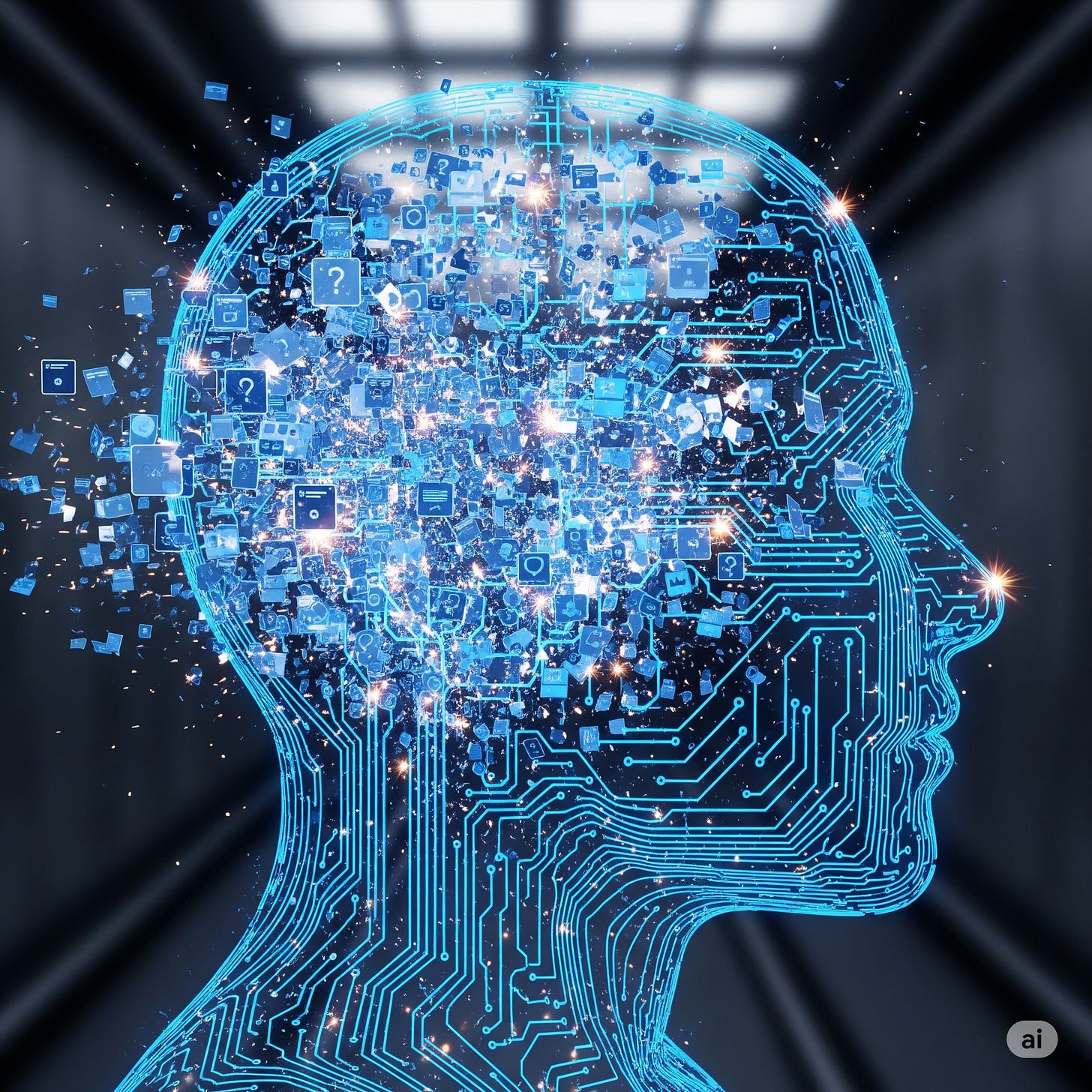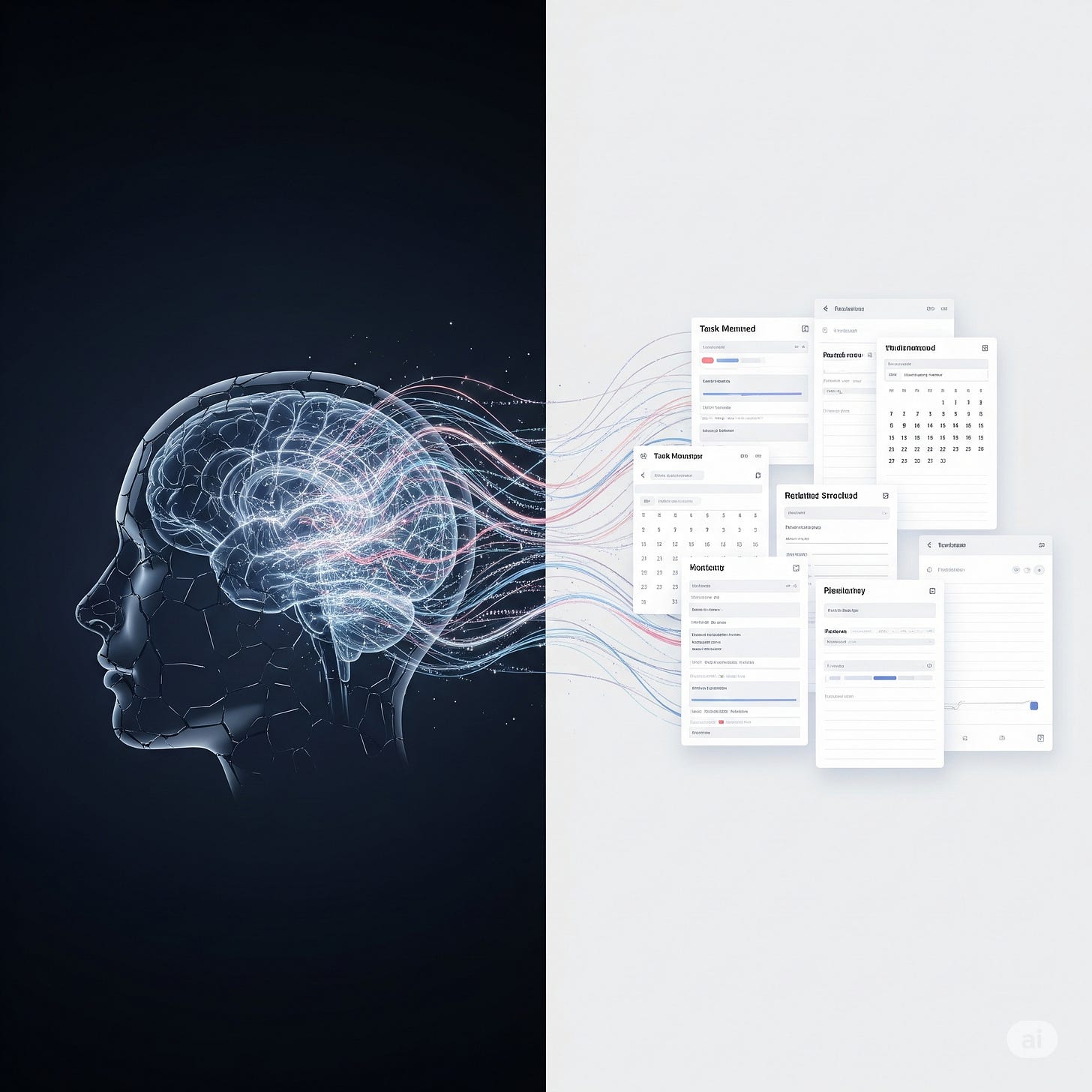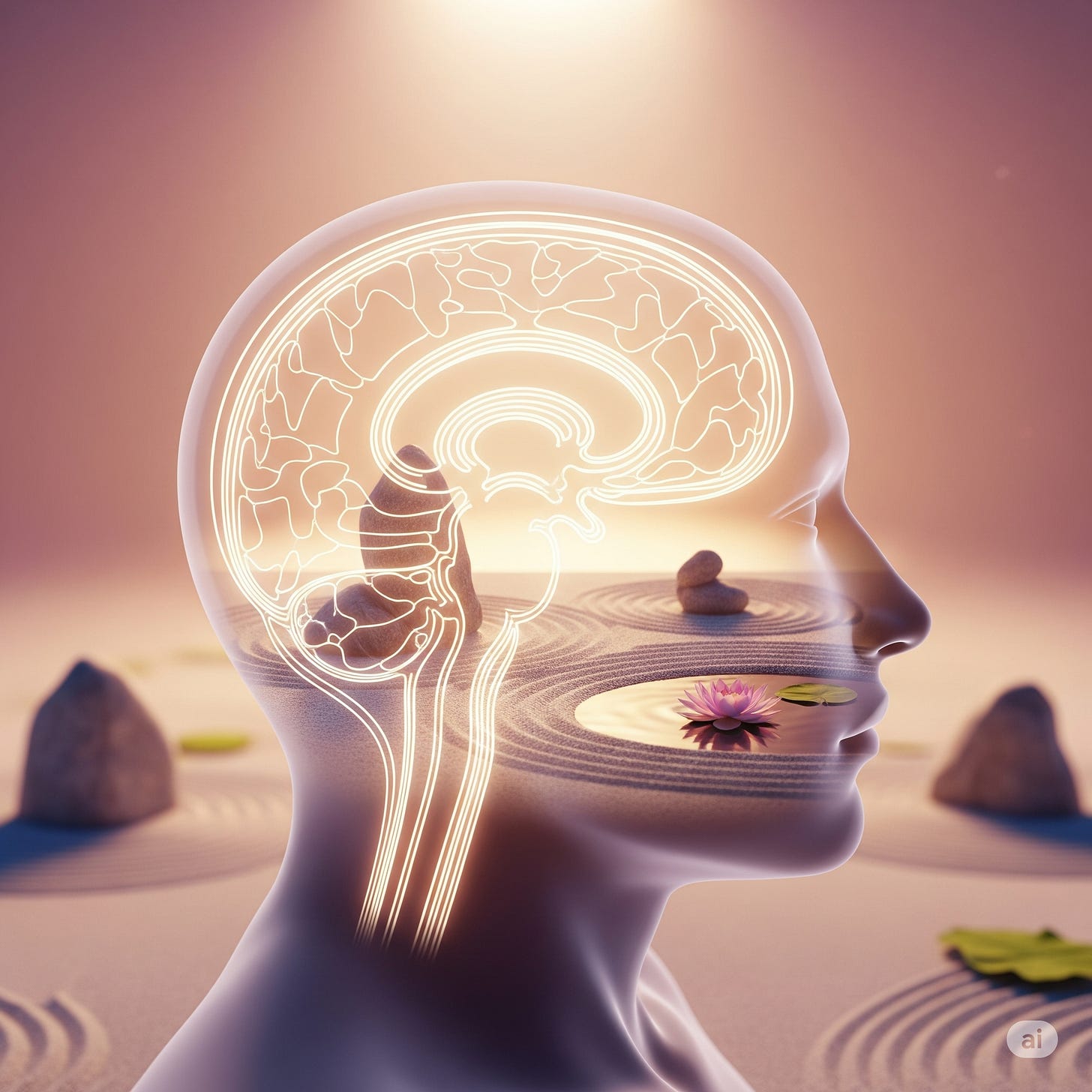The External Brain: Building Productivity Systems That Work With Your ADHD Mind
The Silent Chaos Stealing Your Potential
Picture this: You have a brilliant idea during your commute, but by the time you reach your destination, it's completely vanished. You remember you have an important task to do, but can't recall what it was or when it's due. Your mind feels like a browser with 47 tabs open, each demanding attention while making it impossible to focus on any single thing.
This is the reality of internal chaos for ADHD minds—and it's silently sabotaging your productivity every single day.
For neurodivergent brains, particularly those with ADHD, the biggest struggle often isn't external distraction. It's the relentless, self-generated mental chaos: brilliant ideas that evaporate before you can record them, crucial tasks that slip through working memory, and the exhausting feeling of mental fragmentation.
Traditional productivity advice misses the mark entirely. "Just focus." "Be more organized." "Try harder." These suggestions betray a fundamental misunderstanding of how ADHD brains actually work. They're not broken—they're simply wired differently and often operating in constant overload.
The solution isn't fixing your internal system—it's building an external one.
This article provides a systematic blueprint for constructing your own "External Brain"—an intelligent, strategically designed extension of your cognitive capacity that offloads mental burden, provides unwavering structural support, and gives you back control over your productivity.
This isn't about quick fixes or motivational mantras. It's about building foundational systems that work with your unique neurology, not against it.
The Hidden Cost of Mental Overload
Before building solutions, let's understand exactly how internal chaos drains your potential. This cognitive overhead isn't just inconvenient—it's a systematic drain that undermines productivity, creates emotional exhaustion, and actively dissipates your capabilities.
The Dopamine Drain: When Your Brain Fights Itself
ADHD brains already struggle with dopamine regulation, and constant internal disorganization makes it worse. The perpetual mental effort of sorting, remembering, reprioritizing, and recalling tasks consumes vast amounts of mental energy.
This continuous internal churning depletes your prefrontal cortex resources and dramatically increases "activation energy"—the mental cost required to simply start a task. When your brain is already exhausted from managing its own chaos, beginning productive work becomes monumentally difficult.
Think of it like running a computer with 50 programs open simultaneously. Everything slows down, simple tasks become laborious, and eventually the whole system crashes.
Analysis Paralysis: When Too Many Options Freeze You
An overloaded working memory leads directly to analysis paralysis. With too many open cognitive loops, unclear priorities, and constant fear of forgetting crucial details, your mind enters perpetual indecision.
When every decision feels like navigating a minefield of potential oversights, inaction becomes the default. Your brain chooses the path of least resistance, which is often no action at all.
Oliver Wendell Holmes noted, "The mind, once stretched by a new idea, never returns to its original dimensions." But when your mind is overstretched by chaos, it struggles desperately to reclaim any clarity.
The Tangible Costs: What Internal Chaos Actually Costs You
The consequences of unmanaged internal chaos are measurable and significant:
Missed deadlines that appear without warning
Forgotten commitments that damage professional relationships
Lost opportunities because follow-up tasks slip through cracks
Incomplete projects abandoned when complexity overwhelms
Duplicated efforts from forgetting previous work
These aren't isolated incidents—they're systematic failures of an overtaxed internal system.
The Emotional Tax: Stress, Shame, and Exhaustion
Beyond measurable losses lies a profound emotional toll:
Chronic low-grade anxiety about what might be forgotten
Persistent frustration from feeling unproductive despite genuine effort
Shame and inadequacy from the internal narrative of constant "failure"
Burnout from the invisible work of managing mental chaos
This emotional burden often leads to cycles of overcommitment followed by under-delivery, undermining your authenticity and self-confidence.
The "Invisible Work" Problem
Perhaps most insidious is the "invisible work" tax—the constant mental effort dedicated to self-correction, recall, priority sorting, and generating new organizational strategies.
This cognitive labor consumes valuable bandwidth that could be directed toward high-value creative work, problem-solving, or skill development. It's unbilled, unrecognized work that persistently drains energy from activities that actually advance your goals.
The External Brain Framework: Your Cognitive Liberation Strategy
Now that we understand the costs of internal chaos, let's build the solution: systematic principles for offloading cognitive burden from your working memory to external, completely reliable systems.
Core Principle: Trust and Strategic Offload
The fundamental premise is deceptively simple yet profoundly transformative: Your brain is designed for complex thinking, creative connections, and problem-solving—not storage.
Using your biological brain as a repository for every fleeting idea, pending task, or piece of information misappropriates its highest functions. The goal is constructing an external system so reliable that your mind can safely "forget" without any fear of loss.
As productivity expert David Allen states: "Your mind is for having ideas, not for holding them." This liberation of cognitive bandwidth is the primary benefit.
The Capture Imperative: Never Lose Another Idea
The first non-negotiable component is a ubiquitous, frictionless capture system. Every idea, task, or piece of information—regardless of apparent importance—gets immediately captured into a trusted, accessible tool.
This is your primary defense against internal chaos, preventing brilliant thoughts from dissolving and mental clutter from accumulating.
Essential capture tools:
Always-present notebook for immediate physical capture
Voice memo apps for hands-free idea recording
Quick notes widgets on your phone's home screen
Physical inbox for papers and documents
The tool matters less than the habit. Remove all barriers to capturing new information.
Processing and Organization: Imposing Logical Order
Captured information alone is just static data. Its value emerges through consistent, disciplined processing and organization systems.
Essential processing routines:
Daily Tidy (5-10 minutes)
Consolidate scattered notes into your main system
Clear digital inboxes and assign next actions
Ensure nothing lingers unprocessed
Weekly Review (30-45 minutes)
Comprehensive sorting and prioritization session
Apply the 80/20 principle: identify vital few items requiring immediate action
Archive or discard trivial many items
Plan upcoming priorities and deadlines
This systematic processing ensures your external brain remains lean, current, and trustworthy.
Projectization: Breaking Down Overwhelming Complexity
The most paralyzing aspect of internal chaos stems from life's perceived enormity and ambiguous nature. The External Brain counters this by systematically breaking down large responsibilities into manageable projects.
The projectization process:
Identify major life areas (career, health, relationships, finances)
Define specific projects within each area with clear outcomes
Break projects into discrete tasks with unambiguous next actions
Assign realistic timelines and priority levels
This systematic decomposition transforms nebulous mountains into series of conquerable hills, allowing your ADHD mind to engage with manageable progress units rather than overwhelming wholes.
Building Your External Brain: Tactical Implementation
Having established the foundational principles, let's move to practical implementation. This section provides specific tools and actionable strategies for constructing each component of your functional External Brain.
Task Management: Beyond Simple To-Do Lists
For ADHD minds, linear to-do lists are often insufficient. You need dynamic systems that account for novelty-seeking, visual structure, and clear next actions.
Recommended tools:
Visual Board Systems (Trello, Asana)
Use "To Do," "Doing," "Done" columns for immediate progress visibility
Color-code by priority, project, or energy level required
Leverage satisfying movement from column to column for dopamine rewards
Structured List Systems (Todoist, Omnifocus)
Natural language input for quick task entry
Project hierarchies with subtasks and dependencies
Context-based organization (calls, computer work, errands)
Strategic implementation:
Categorize by energy level (high-focus, low-focus, quick wins) to match natural cognitive fluctuations
Use both due dates and start dates to avoid last-minute panic patterns
Assign specific "next actions" for every project to eliminate ambiguity
Information Management: Your Digital Knowledge Hub
ADHD minds generate high volumes of ideas but struggle with information recall and organization. A centralized, searchable system for all information becomes critical.
Recommended platforms:
All-in-One Systems (Notion)
Dynamic notes, project management, and custom databases
Linked page structure prevents information fragmentation
Template systems for consistent organization
Traditional Note Systems (Evernote, OneNote)
Flexible notebook organization
Web clipping for research capture
Powerful search across all content
Connection-Based Systems (Obsidian)
Direct note linking for non-linear thinking
Visual graph of idea connections
Excellent for research and knowledge development
Implementation strategies:
Establish single "Inbox" for all digital inputs processed daily
Implement consistent tagging and linking for easy retrieval
Create information templates for meeting notes, project planning, and research
Strategic Automation: Reducing Cognitive Load
One of the most powerful strategies for freeing mental bandwidth is automating repetitive tasks and information flows.
Essential automation categories:
Task Integration (IFTTT, Zapier)
Auto-save email attachments to cloud storage
Create tasks from emails or calendar events
Cross-platform information synchronization
Time-Based Automation (Calendar, Reminders)
Recurring bill payment alerts
Regular review session scheduling
Deadline and commitment reminders
Input Efficiency (Text Expansion, Keyboard Shortcuts)
Common email templates and responses
Frequently used phrases and addresses
Code snippets and formatting shortcuts
Key principle: "What can be automated, should be automated. Your genius lies in the exceptions, not the rules."
Physical Environment: The Tangible External Brain
Your external brain extends beyond digital systems. A chaotic physical environment directly mirrors and worsens internal disorganization.
Essential physical systems:
Landing Strips
Single designated area near entry for keys, wallet, phone
Eliminates frantic searching and decision fatigue
Consistent location becomes automatic habit
Categorized Storage
Clear, labeled storage for item categories
"A place for everything, everything in its place"
Visual organization reduces cognitive load
Daily Reset Routines
5-minute end-of-day declutter sweep
Return misplaced items to designated homes
Maintain order momentum through consistency
Sustaining Your External Brain: The Discipline of Consistency
Building your External Brain isn't a one-time project—it's an ongoing discipline requiring consistent engagement, regular refinement, and fundamental mindset shifts.
The Non-Negotiable: Daily System Engagement
Your external brain functions only when consistently fed and systematically reviewed. This isn't optional—it's the foundation of the entire system.
Essential daily habits:
Immediate capture of every task, idea, or commitment as it arises
Daily processing of inbox items (5-10 minutes)
Evening review of tomorrow's priorities and commitments
Weekly maintenance:
Comprehensive review of all projects and areas
System cleanup and organization refinement
Priority adjustment based on changing circumstances
As Jocko Willink emphasizes: "The more you drill, the less you bleed." Consistency in maintenance prevents system breakdown when you need it most.
Adaptive Refinement: Evolution, Not Perfection
Your external brain must adapt to your unique ADHD patterns, not force you into rigid structures. If particular tools or processes aren't working, iterate without hesitation.
Refinement principles:
Function over form: Prioritize what works over what looks perfect
Regular system audits: Monthly reviews of what's helping vs. hindering
Gradual improvements: Small tweaks compound over time
User-centered design: Your system serves you, not vice versa
Building Your Future Self Through System Habits
Every interaction with your external brain is a vote for who you're becoming. When you capture thoughts, process tasks, or clear inboxes, you're actively embodying a disciplined, organized, highly effective future version of yourself.
These consistent, small acts of engagement are intentional identity affirmations, incrementally forging a more capable and integrated version of yourself.
The Liberation of Trusted Systems
The ultimate benefit of a consistently maintained external brain is profound cognitive liberation. As you develop unwavering trust in your external systems, your biological brain can relax.
This frees precious mental resources previously consumed by:
Internal remembering and tracking
Constant self-correction and worry
Priority sorting and re-sorting
Information retrieval attempts
The result is increased mental clarity enabling deeper focus on high-value creative work and complex problem-solving.
Resilience Through Realistic Expectations
Embrace the Stoic principle of realistic acceptance. There will be days when systems feel burdensome, when old patterns re-emerge, or when maintenance falters.
These aren't failures—they're predictable friction points in the evolution of self-mastery. View them as opportunities for system refinement and deeper understanding of your evolving needs.
Your commitment is to ongoing effort and improvement, transforming challenges into catalysts for strategic advantage.
Your Implementation Action Plan
We've diagnosed internal chaos costs, outlined foundational principles, and detailed tactical components for building your External Brain. The value is clear, but transformation requires immediate, decisive action.
Your Three-Step Implementation Process
Step 1: Identify Your Most Disruptive Chaos
Pinpoint your single biggest productivity drain:
Mental sorting overload consuming cognitive bandwidth?
Analysis paralysis from too many open loops?
Missed commitments eroding trust and reputation?
Information loss preventing project completion?
Step 2: Choose One External Brain Component
Select the most impactful solution for your identified problem:
Ubiquitous capture system for disappearing ideas
Visual task management for overwhelming project lists
Strategic automation for repetitive mental drains
Physical organization for environmental chaos
Step 3: Implement Today
Apply your chosen component with unwavering commitment:
Start small but be absolutely consistent
Remove implementation barriers in advance
Track early wins to build motivation momentum
Iterate based on real usage rather than theoretical ideals
The Promise of External Mastery
This isn't about overnight transformation—it's about systematic momentum building toward cognitive mastery. Each component you implement, each routine you establish, each capture you make moves you closer to the mental clarity and consistent productivity you're seeking.
Remember: Your brain is designed for brilliance, not storage. Give it the external support it deserves, and watch your true capabilities emerge.
Your journey from internal chaos to external mastery starts with one deliberate action. Take it today.




